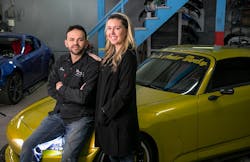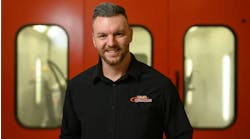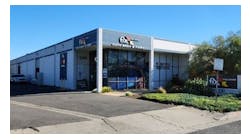There was a moment for Daniel Inez. A seemingly minor idea that could have amounted to nothing, could have opened no new doors, could have been just another dead-end venture that failed to take his collision repair business anywhere.
There was also a moment for Shawn Crozat. A tweak to operations that could have been a money pit, could have been too crazy to ever really work, could have caused his growing multi-shop network to hit a standstill.
But here’s the thing: These moments—these pivots, if you will—instead took each business to new heights and territories. By taking a chance, by constantly trying to differentiate their business models, each owner hit on something that separated them from the competition.
In Inez’s case, it was taking advantage of an untapped market to bring Dan’s Auto Body in Peabody, Mass., out of a van and into a 5,000-square-foot facility that today pulls in $3 million per year. For Crozat, it was creating a solution to the industry’s employee shortage to further grow his now 11-shop network.
So whether it’s simply getting your business off the ground, or it’s setting your shop up for expansion, both stories highlight how one ostensibly inconsequential moment can go on to completely reshape your business. All it requires is the perseverance, courage and fortitude to turn those moments into game-changing decisions.
That’s a Wrap
How Daniel Inez focused on custom work to build his database and integrate into the collision repair market
SHOP STATS: Dan’s Auto Body Location: Peabody, Mass. Shop Size: 5,000 square feet Staff Size: 7 Average monthly car count: 60 Annual revenue: $3 million
“Why would you want to do that?”
Back in 2012, that was—and to this day remains—a legitimate question. As co-owner of Dan’s Auto Body, Loraya Inez was right to challenge her husband, Daniel, on his crazy idea, especially considering their mobile business had yet to move from a couple Chevrolet Astro vans into an actual collision repair facility. For one year, the newly married couple—who had just moved to Massachusetts to try their hand at the trade—had been doing what it could to get by, buffing out scratches and performing the occasional bumper job, building funds for an upgraded setting.
And then Daniel had the idea: He wanted to focus on custom work.
Which led to Loraya’s question, which you might also now be asking yourself:
“Why would you want to do that?”
In the grand scheme of revenue streaming in from collision repair work, Daniel admits that focusing on low-margin work involving vinyl wrap and Plasti Dip seems like a waste of time, energy and resources. But for him, it wasn’t about the margins—it was about the opportunity the work presented.
The Idea
The art of the pivot goes beyond the inception of an idea. Daniel says it involves weighing your options, evaluating your environment and, most importantly, asking questions and challenging the status quo.
So, logistically, could vinyl wrapping become a sustainable model for the entire business? And could the Inezes abandon collision repair and work toward an entirely new market? Possibly—but probably not, Daniel admits.
However, Daniel had another set of questions he wanted to answer:
Could custom work become an accent to the business’s model?
“It wasn’t a huge investment for us to invest in the right materials and equipment,” he says. “Our name—Dan’s Auto Body—was still on the van, so people knew what kind of company we were.”
Would it differentiate Dan’s Auto Body from the stiff competition in Peabody?
“There were no other collision repair shops in New England doing it,” Loraya says. “So it gave us an automatic edge over everyone else.”
And above all else: Could this low-margin work lay the seeds for building a customer database that would one day facilitate a profitable collision repair business?
“It’s not a huge moneymaker, but we thought, ‘If we do custom work on their car and they’re happy with it, down the line if something happens, they’re going to bring it back to us.’”
It felt like a long shot at the time, the Inezes say. But they hoped that taking that small chance would return huge rewards.
“It was us versus every other body shop in the area that had been in business for 30 years,” Daniel says. “So we had to try something different.”
The Pivot
The Inezes went all in on their idea. Relying heavily on their business’s Facebook and Instagram pages, the couple began to show off the visually appealing work their vinyl wrapping and Plasti Dip services offered. The key the entire time, they say, was the name that accompanied those posts: Dan’s Auto Body.
“If people needed a fix and wanted to get work done, we were the go-to for them,” Loraya says.
The Big Pivot
Andrew Winston is the author of The Big Pivot, which was published in 2014 by the Harvard Business Review Press. In the book, he outlines several strategies successful businesses have used to shift their business models.
“As the world continually changes, business owners need to be able to change and navigate through these thorny problems,” Winston says. “The ’pivot’ for a business owner is to not just think of their job as maximizing earnings in the short term, but to solve customers’ and the world’s problems in a profitable manner.”
Winston spoke with FenderBender to highlight a few important components of successfully completing the art of the pivot.
Understand Your Place in the World
Even if you run a small business, Winston says, you connect to or have a role in the biggest issues of the day—even large-scale items like a changing climate and energy and water use.
“Thinking about how you connect with the community and the world can change your mindset,” he says. “If we thought about what we do for our customers but also helping to manage our energy and waste, what would we do differently? How would we think about our business?”
Winston says this shift in mindset could lead you down a new path that not only creates a new process or proves more profitable, but also creates a great impression locally.
“The people in your community will view you as a leader if you’re connected with the larger issues affecting everybody,” he says.
For two years, the couple performed the custom work, slowly accruing more and more minor collision work along the way. Daniel would repair, paint, sand and buff every vehicle himself, and Loraya would handle the estimates and financials.
Business was slow at first, but the small, low-margin work soon began to pay dividends, causing, as Daniel puts it, a “domino effect.”
“Say somebody comes in with a BMW and they do their whole car with a lime green wrap,” he says. “If they get into a car accident a year later, they almost have to bring it back to us, since we’re the only people that offer that and we did the job in the first place.”
Since the Inezes’ clientele tended to own high-end vehicles, the custom work was starting to be accompanied with more expensive repairs, building to the point where it started bringing in more business than the couple could handle.
“We had people contacting us from different states, just because they saw details and the quality of finishes we were doing,” Daniel says.
They purchased one more van, hired one more staff member, all before they finally had accrued enough funds to move into their first facility two years ago.
The Next Step
For the Inezes, their pivot resulted in a 5,000-square-foot facility that now staffs seven (including four technicians and one estimator), has an average monthly car count of 60 and an annual revenue of $3 million in its second full year as a non-mobile business.
These days, custom work is a very small component of Dan’s Auto Body output and revenue, yet it still retains the eye-catching appeal that launched the business in a new direction five years ago—especially when your clients include players from the Boston Celtics and the New England Patriots.
“Everybody is watching the Patriots game. So when Dion Lewis scored two touchdowns in the first quarter, we immediately posted photos on our page of the car we did for him,” Loraya says. “So now everyone is thinking, ‘If Dion can trust them, I can too.’”
“All those long hours have really paid off,” Daniel says. “The vinyl wrapping work led to everything. Now we can learn how to lead a team and run a profitable shop.”
The Minor League
How Shawn Crozat implemented estimator classes and technician apprenticeships to grow his shop network
SHOP STATS: G&C Auto Body Location: 11 facilities in California Staff Size: 215 Average monthly car count: 1,500 Annual revenue: $50 million
“We want to build our own future.”
That seems like a pretty straightforward mantra for a business to adapt, right? Shawn Crozat thinks so. He says all businesses should be looking to grow talent from within, promoting its employees, handing out more responsibilities.
However, Crozat’s pivot had to acknowledge one simple fact two years ago: His growing multi-shop network, G&C Auto Body, wasn’t fully committed to living by that mindset—in fact, he would venture most collision repair shops don’t either.
To this day, Crozat still does his part to fix the technician shortage by working with area vocational colleges and high schools in California. However, prior to 2015, connecting with schools was his only avenue for finding quality employees outside of job advertisements. And for his growing shop network, which had gone from three to six locations between 2011 and 2015, the inability to find quality employees—both estimators and technicians—would inhibit the company’s ability to grow effectively.
“I see a lot of people talk about UTI and trade schools. I’ve seen shop operators say there should be a government initiative, or that there should be more classes at colleges for collision repair,” Crozat says. “What’s tough to realize is it’s up to us to fix the problem. And I don’t think all independent shop owners are willing to make the financial sacrifice for that.”
The Idea
Throughout the year, 30 different people will sit in this classroom. Their ages range from early 20s to late 40s. Their scattered backgrounds stem from just about any profession that’s not collision repair.
And they’re all here to become estimators at G&C Auto Body.
In addition to working with schools, Crozat decided to invest the funds required to build his own in-house recruiting system, which involved creating a course that would weed out poor job candidates. Crozat hired his sister-in-law and former estimator, Tara, full-time to lead a four-week estimating class, which is offered every other month to job candidates at one of G&C’s locations (there are currently 11). The course is rigorous, intense, and more than half of the students fail to make it through.
Crozat drew inspiration from a very common practice in the professional sports realm.
“Every major baseball team has its own AA or AAA team,” he explains. “There’s a minor league to pull players from when you need them. So that was our thought, to build up our own farm league.”
From technicians to estimators to managers, Crozat wanted to ensure that every future location would be equipped with employees dedicated to the G&C model. So he began putting together his farm team.
The Pivot
Crozat and his sister-in-law—one of the company’s top estimators at the time—not only formed a curriculum, but also brainstormed how to advertise it and, eventually, duplicate it for technicians.
Their marketing approach was simple: Don’t just invite industry professionals, but bring in job candidates from all sorts of sales and administrative backgrounds.
The kicker, and the key to ensuring they received quality applicants, was this promise: If you complete the program, you’ll earn a $65,000-$85,000 salary within two years of employment at G&C.
“We don’t care if you have a college education or not,” Crozat says. “If you’re willing to put in the work, you’ve got a shot with us.”
The four-week training course trains candidates in the business’s estimating and management software. Additionally, they spend time role playing, going through various estimating components through hands-on training with Tara and technicians in the shop. The estimator students are also trained on all company SOPs. After graduation, the trainees are placed with a journeyman writer to be mentored until they are ready to go solo.
A similar apprenticeship runs three times per year with technicians. During those periods, approximately 30 apprentice technicians—recruited from schools and job ads—are in rotation, spending 12 weeks under lead techs at each shop, refining their craft and studying SOPs.
Crozat incentivizes job candidates by offering to pay for estimating courses and apprenticeships. Any new hires then go on a baseline salary, and can eventually earn the salary Crozat advertises.
Likewise, mentors, who will undoubtedly lose efficiency during training, are compensated for the extra work.
The Next Step
The results have been phenomenal, Crozat says. While he invests heavily to run the program each year, it’s been more than offset by the increases in efficiency and revenue at each of his locations. As he’s grown from six to 11 shops over the past two years and increased total annual revenue from $32 million to $45 million, he claims to have little problems outfitting new shops immediately with quality employees.
Because of the program, the business has also seen several employees move quickly through the ranks, including a 26-year-old former estimator who now runs a $5.4 million shop.
Crozat runs his ads year round, and offers his employees a $500 finder’s fee for any referrals that turn into hires.
“When you’ve had two years of training under our curriculum, I know you’re not going to fail us,” he says. “That makes it worth it to me. I don’t want to trip over dollars to pick up pennies. I don’t want to have the chance for a new location and not have the people. So I look at it as having the right people in place at all times.”
The Big Pivot (Cont.)
Ask Heretical Questions
A big part is asking yourself heretical questions about your business, which Winston says has historically catapulted some of the world’s biggest companies (think Nike and Amazon) into unprecedented territories.
“I think it’s important to ask yourself, ‘Why have we always done it that way?’” he says. “‘Why don’t we do it this way?’”
While Winston has consulted for huge corporations, he says that asking heretical questions comes much easier for smaller businesses, which tend to be less reliant on “traditional” approaches to business and have more room to explore more progressive ideas.
“As a collision repair shop owner, challenge yourself: ‘Why can’t we teach safe driving? Let’s be the guys that teaches everyone how to not get into accidents.’
“Keeping your car running smoothly, keeping it safe, how to use the safety features on autonomous cars—these are the progressive ideas that can move your business forward in a world that’s going to change.”
Talk to Stakeholders
The “stakeholders” in your business are your employees and customers. Winston says to regularly ask them what they think of your business’s role in the community and how you could improve.
“Especially your millennial employees,” he says. “They might say, ‘Why do we always do it this way? Why aren’t we doing X, Y or Z?’
“And ask customers, ‘What do you think of how we’re running our business? How are we making your life better?’”



